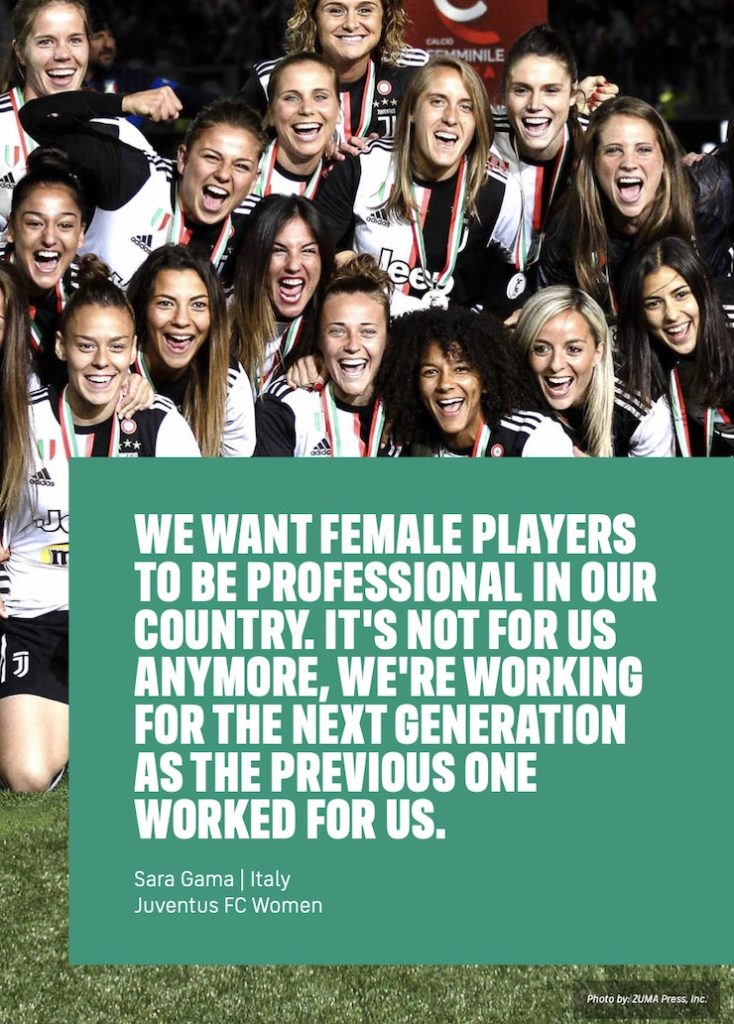FIFPRO’s Raising Our Game Helps Women’s Soccer
A new report from FIFPRO shows the strength and weaknesses of the women’s game. Now, more than ever, a strategy and unity is needed to grow the women’s game in America and around the world.
With insights on sponsorship, broadcast trends and activism as well global minimum standards for international tournaments, this is a must-read report.
FIFPRO is today launching Raising Our Game, a forward-thinking report about women’s professional football which puts players at the heart of the planned development and rebuilding of the sport after the coronavirus pandemic.
The report, compiled with KPMG Football Benchmark, charts the economic evolution of the game, covering match-day attendance, TV audiences and sponsorship, and details player conditions at the club and national team level.
Raising Our Game calls for football stakeholders to work together with us and our 65 affiliated player associations to establish and enforce global standards for working conditions in order to achieve a strong, vibrant, and sustainable women’s game.
“Let’s focus our energies on both rebuilding the game and reimagining what women’s football can become.”
Amanda Vandervort, FIFPRO Chief Women’s Football Officer
The report was originally scheduled for publication in February but was postponed because of the outbreak of the coronavirus. FIFPRO has decided to publish the report now during the pandemic as employment standards remain as important as ever.
FIFPRO General Secretary Jonas Baer-Hoffmann said, “We are conscious that we are releasing this report during an extremely uncertain and worrying time, however, we have a responsibility to the professional footballers we represent to chart the way forward for them and their industry.”
“We are committed to working with all stakeholders in a united and holistic way to relaunch the industry after the coronavirus pandemic,” said Baer-Hoffmann. “The professional players we represent and who devote so much time and energy to the women’s game, often with little reward or compensation, must be at the heart of this rebuilding process.”
The following are the primary objectives detailed in Raising Our Game:
- Global minimum employment standards, which guarantee that professional players have appropriate contracts, compensation, workload, training and match environments, health and safety measures, freedom of association, and access to remedy.
- Global minimum standards at international tournaments to ensure that players participating in elite global competitions—both club and the national team—are protected and can perform at their peak, on an equal footing on the world stage.
- Collective bargaining as a universal industry standard so that professional players around the world have a fair say in the development of their sport.
- New global club and national-team competition formats and scheduling that permits professional players to enjoy a long and sustainable career.

As well as using the most recent data from clubs, leagues, sponsors and tournament organizers including FIFA and regional confederations, the report uses a survey with 186 female national-team players from 18 countries and a stakeholder survey to map out the best way forward.
The research in Raising Our Game shows that there is a growing commercial interest in women’s football. The game has attracted high-profile sponsors and new investors, while the media interest in top competitions has risen.
The report cites that having a stable broadcast agreement and structure to build on is crucial. Raise Our Game also reports on the increase in the in-home audience reach of women’s football.

The club wages of female national team players has increased, with those surveyed receiving an average monthly wage of 4,123 euros.
However, women’s leagues and clubs worldwide have varying degrees of professionalism, and, all too often, short seasons and financial shortcomings are a burden for players.
Those surveyed highlighted a lack of resources and 78 percent were unaware of their club having a clear strategy for growth.
At best, that means that there is a lack of transparency and player engagement and, at worst, that clubs do not have a strategy.
While the number of FIFA member associations with active women’s national football teams rose from 55 percent to 73 percent between 2017 and 2019, this leaves more than one in four federations who do not organize a women’s national team at all.
Furthermore, some associations are under-utilizing the international match calendar windows.

A reoccurring message from players is that the motivation and passion fuelling the women’s game needs proper structural and sustainable resources underpinning it to ensure long-term success. Many are organizing themselves and demanding better conditions.
They are developing collective bargaining agreements with their federations and leagues at the domestic level and joining in solidarity with their peers at an international level.
Some see their role extending beyond the pitch, using their growing popularity and visibility to unite their struggle for women’s rights and employment rights with social justice movements off the pitch.
Amanda Vandervort, FIFPRO Chief Women’s Football Officer, said: “We are adamant that the priority of everyone in society, including the football community, is the health and safety of their loved ones at this moment, but we also have a duty to players and to plan for the restart of football.
“Women’s football has demonstrated its tremendous economic potential and shown that it is an asset of great value to sport and society,” said Vandervort.
“We want Raising Our Game to serve as a guiding light to help turn recent momentum into transformative change,” said Vandervort.
Source: Press Release





